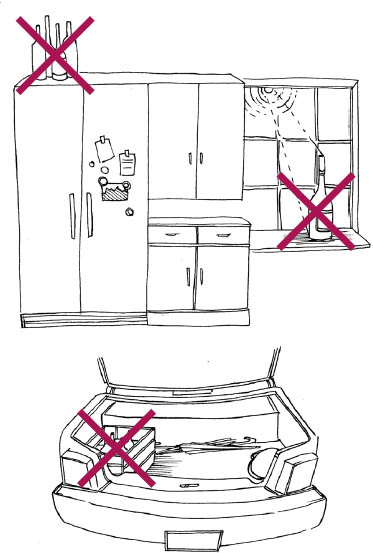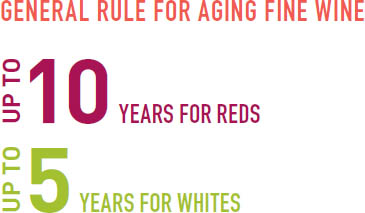
There are entire books dedicated to caring for wine, but the honest truth is, most of the time, it’s not that important; nowadays, our wine is long gone before there’s a chance that anything could happen to it. (Studies have shown that in the United States, the average time between the purchase of a bottle of wine and consumption of that bottle is around four hours!) If you buy a bottle and plan to drink it within hours or days, you don’t have to worry too much about where and how you store it. Just remember not to let it get too hot and you’ll be fine. However, if you’ve got a special bottle in your possession—one that you plan on keeping for a while—how you tend to it is crucial to how the wine will taste when you open it.
Most important, wine needs a consistently cool temperature. Wine scientists have discovered that 55 degrees Fahrenheit is the ideal temperature for long-term storage (longer than a few months). Temperatures substantially warmer than that can lead to a premature demise, and temperatures a lot cooler can retard the wine’s evolution. Wine also needs to hibernate in a cozy, dark, and still place. Heat, light, and vibration can all do damage. Last, humidity is important to consider when storing wines with corks. Over time, a dry cork gets porous and lets too much air leak in. Keep the inner end of a cork moist and supple by laying the bottle on its side. Keep the outer end moist by storing it in a location with at least 65 to 75 percent humidity.

Obviously, underground wine cellars, basements, and wine refrigerators are all ideal for long-term wine storage. If you don’t have access to a dark underground hole and don’t want to spring for an expensive wine refrigerator, the next best option is to store your wines on their side at the bottom of an interior-walled closet. It’s not glamorous, but it takes care of most of the requirements, and your wines will thank you by tasting delicious.
Cooked is slang for a bottle that’s been damaged by heat, the most widespread and common form of wine abuse. It doesn’t take long for heat to take its toll on wine, and the temperatures don’t have to be extreme either. Sadly, in the time between when a wine is bottled and when it hits your lips, there are many opportunities for heat to harm it. Wine is vulnerable when it’s still at the winery, on shipping containers traveling across the ocean, on delivery trucks, in distributor warehouses, at wine shops, in restaurants, and once it’s home with you. Following is a list of what higher temperatures over an extended period of time, or repeated temperature variation, can do.
1. Higher temperatures can increase the wine’s aging rate. It might sound desirable, but speedy wine aging is not a good thing. It simply means your wine is going to die faster, without the delectable side benefit of tertiary aromas and flavors that can only develop over a long period of slow, steady aging. Some things just take time.
2. Thermal expansion may cause the cork to push up from the bottle and wine to leak from the top. When opening a bottle of wine, if a track of wine is visible along the length of the cork or at the top of the cork, or the cork is partially pushed out of the bottle, it has most likely been heat damaged.
3. Heat-damaged wines often become prematurely oxidized, making them taste old and flat. As you now know, a tiny amount of oxygen exchange does occur with natural cork over an extended time period. Repeated temperature variation, however, can vary the pressure differential between the inside and outside of the bottle so much that it can actually pump air into the bottle, causing premature oxidation. Oxidized red wines may take on an orangey brick color; white wines a dark yellowish brown hue.

How long do you age wine? There’s no short answer to this common question; following are just the most important factors to consider.
If the wine costs less than twenty-five dollars or so, forget aging it altogether—just drink that baby. The number-one determinant of longevity is quality. You’ve got to start with good ingredients. As you already know, high price does not always mean high quality, but you should still count low-priced wines out; they are not meant for longterm cellaring.
This does not mean that all expensive wine has the capacity to taste good in ten or twenty years. The truth is, less and less wine is being made with the intention of aging. Winemakers know that consumers are impatient and want what they want now. So instead of designing wines for longterm cellaring, they are using a variety of winemaking techniques and farming practices to create wines that are ripe, lush, and friendly right out of the gate. The point is that more and more wines don’t require any aging at all. They are meant to be consumed immediately.
If you have been bad, and your special bottle of wine has been sitting somewhere I would disapprove of—on top of the fridge or radiator, on the kitchen windowsill, or in the trunk of your car—drink it now. I won’t reprimand you. Fine wine neglect is punishment enough in itself, as you’ll likely discover when you open the bottle. If you’ve been good, though, storing your fine wines properly, you can keep them longer. Optimally, time and the right conditions equal complexity and a seamless integration of flavors.
Your taste buds rule, really. No matter what the experts say, how you like your wine (just like how you like your coffee or your kisses) is the ultimate indicator of your level of enjoyment. If you appreciate more subtlety and delicacy in your wines, wait a little longer to drink them. Time softens tannin, fades fruit, and introduces more earthy secondary flavors and aromas. If you like more everything in your wine—power, structure, grip, fruit—drink your wines when they are young.

There is no magic date to open a bottle, but that’s part of wine’s allure. It’s always changing and it keeps you guessing. The most qualified people to recommend a particular wine’s peak date are the people who know it best: the winemakers who have a long history of tasting many vintages of the same wine. They can most accurately predict how a wine will change over time, based on their years of experience with and intimate relationship to that wine. (Almost all wineries have winemaker’s tasting notes on their websites.) But even experts get surprised. I can’t tell you how many times a wine or even a whole vintage of wines from a region has been hailed as “terrific” or “the best” only to fall flat over time. Conversely, a wine that may have scored poorly upon release can be tasted again years later and pleasantly surprise everyone. This is the reason collectors buy a case of the same wine and try a bottle every few years. It is fascinating to study how wine evolves.
Whatever you do, don’t wait too long. It is much better to err on the side of caution and drink a wine a little early than to wait with bated breath in anticipation of perfection, only to open a crusty, crunchy, expensive bottle of vinegar.
The very best examples of the following wines are proven graceful agers.
Whites
Reds
Sweet Wines